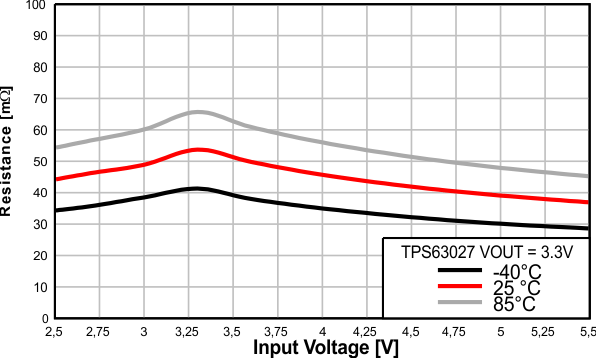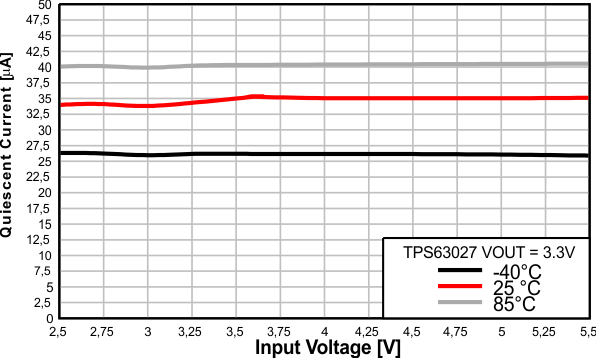SLVSDK8 December 2016 TPS63027
PRODUCTION DATA.
- 1 Features
- 2 Applications
- 3 Description
- 4 Typical Application
- 5 Revision History
- 6 Device Comparison Table
- 7 Pin Configuration and Functions
- 8 Specifications
- 9 Detailed Description
- 10Application and Implementation
- 11Power Supply Recommendations
- 12Layout
- 13Device and Documentation Support
- 14Mechanical, Packaging, and Orderable Information
Package Options
Mechanical Data (Package|Pins)
- YFF|25
Thermal pad, mechanical data (Package|Pins)
Orderable Information
8 Specifications
8.1 Absolute Maximum Ratings
over junction temperature range (unless otherwise noted)(1)| MIN | MAX | UNIT | ||
|---|---|---|---|---|
| Voltage(2) | VIN, L1, L2, EN, VINA, PFM/PWM, VOUT, FB | –0.3 | 7 | V |
| Input current | Continuos average current into L1(3) | 2.7 | A | |
| Operating junction temperature, TJ | –40 | 125 | °C | |
| Storage temperature, Tstg | –65 | 150 | °C | |
(1) Stresses beyond those listed under Absolute Maximum Ratings may cause permanent damage to the device. These are stress ratings only, which do not imply functional operation of the device at these or any other conditions beyond those indicated under Recommended Operating Conditions. Exposure to absolute-maximum-rated conditions for extended periods may affect device reliability.
(2) All voltage values are with respect to network ground pin.
(3) Maximum continuos average input current 3.5 A, under those condition do not exceed 105°C for more than 25% operating time.
8.2 ESD Ratings
| VALUE | UNIT | |||
|---|---|---|---|---|
| V(ESD) | Electrostatic discharge | Human-body model (HBM), per ANSI/ESDA/JEDEC JS-001(1) | ±2000 | V |
| Charged-device model (CDM), per JEDEC specification JESD22-C101(2) | ±500 | |||
(1) JEDEC document JEP155 states that 500-V HBM allows safe manufacturing with a standard ESD control process.
(2) JEDEC document JEP157 states that 250-V CDM allows safe manufacturing with a standard ESD control process.
8.3 Recommended Operating Conditions
See (1)| MIN | NOM | MAX | UNIT | ||
|---|---|---|---|---|---|
| VIN | Input voltage | 2.3 | 5.5 | V | |
| VOUT | Output voltage | 1 | 5.5 | V | |
| TA | Operating ambient temperature | –40 | 85 | °C | |
| TJ | Operating virtual junction temperature | –40 | 125 | °C | |
(1) Refer to the Application and Implementation section for further information
8.4 Thermal Information
| THERMAL METRIC(1) | TPS63027 | UNIT | |
|---|---|---|---|
| YFF (DSBGA) | |||
| 25 PINS | |||
| RθJA | Junction-to-ambient thermal resistance | 62.1 | °C/W |
| RθJC(top) | Junction-to-case (top) thermal resistance | 0.4 | °C/W |
| RθJB | Junction-to-board thermal resistance | 10.4 | °C/W |
| ψJT | Junction-to-top characterization parameter | 0.2 | °C/W |
| ψJB | Junction-to-board characterization parameter | 10.5 | °C/W |
| RθJC(bot) | Junction-to-case (bottom) thermal resistance | N/A | °C/W |
(1) For more information about traditional and new thermal metrics, see the Semiconductor and IC Package Thermal Metrics application report.
8.5 Electrical Characteristics
VIN= 2.3 V to 5.5 V, TJ= –40°C to +125°C, typical values are at TA= 25°C (unless otherwise noted)| PARAMETER | TEST CONDITIONS | MIN | TYP | MAX | UNIT | |
|---|---|---|---|---|---|---|
| SUPPLY | ||||||
| VIN | Input voltage range | 2.3 | 5.5 | V | ||
| VIN;LOAD | Minimum input voltage to turn on into full load | IOUT = 2 A | 2.8 | V | ||
| IOUT | Continuous output current(1) | VIN ≥ 2.5 V, VOUT = 3.3 V | 2 | A | ||
| IQ | Quiescent current, VIN | IOUT = 0 mA, EN = VIN = 3.6 V, VOUT = 3.3 V TJ = –40°C to +85°C, not switching (PFM Mode) |
35 | 70 | μA | |
| Quiescent current, VOUT | IOUT = 0 mA, EN = VIN = 3.6 V, VOUT = 3.3 V TJ = –40°C to +85°C, not switching (PFM Mode) |
12 | μA | |||
| ISD | Shutdown current | EN = low, TJ = –40°C to +85°C | 0.1 | 2 | μA | |
| UVLO | Undervoltage lockout threshold | VIN falling | 1.6 | 1.7 | 2 | V |
| Undervoltage lockout hysteresis | 60 | mV | ||||
| Thermal shutdown | Temperature rising | 140 | °C | |||
| Thermal shutdown hysteresis | 20 | °C | ||||
| LOGIC SIGNALS EN, PFM/PWM | ||||||
| VIH | High-level input voltage | VIN = 2.3 V to 5.5 V | 1.2 | V | ||
| VIL | Low-level input voltage | VIN = 2.3 V to 5.5 V | 0.4 | V | ||
| Ilkg | Input leakage current | EN = GND or VIN | 0.01 | 0.2 | μA | |
| OUTPUT | ||||||
| VOUT | Output voltage range | VIN = 3.6 V, IOUT = 100 mA | 1 | 5.5 | V | |
| VFB | Feedback regulation voltage | 0.8 | V | |||
| VFB | Feedback voltage accuracy | PWM mode | –1% | 1% | ||
| VFB | Feedback voltage accuracy(3) | PFM mode | –1% | 1.3% | 3% | |
| IPWM/PFM | Output current to enter PFM mode | VIN = 3 V; VOUT = 3.3 V | 350 | mA | ||
| IFB | Feedback input bias current | VFB = 0.8 V | 10 | 100 | nA | |
| RDS;ON(Buck) | High-side FET on-resistance | VIN = 3 V, VOUT = 3.3 V | 48 | mΩ | ||
| Low-side FET on-resistance | VIN = 3 V, VOUT = 3.3 V | 56 | mΩ | |||
| RDS;ON(Boost) | High-side FET on-resistance | VIN = 3 V, VOUT = 3.3 V | 33 | mΩ | ||
| Low-side FET on-resistance | VIN = 3 V, VOUT = 3.3 V | 56 | mΩ | |||
| IIN | Average input current limit(2) | VIN = 3 V, VOUT = 3.3 V TJ = 65°C to 125°C | 3.5 | 4.5 | 5 | A |
| fSW | Switching frequency | 2.5 | MHz | |||
| RON_DISC | Discharge ON-resistance | EN = low | 120 | Ω | ||
| Line regulation | VIN = 2.8 V to 5.5 V, IOUT = 2 A | 7.4 | mV/V | |||
| Load regulation | VIN= 3.6 V, IOUT = 0 A to 2 A | 5 | mV/A | |||
(1) For minimum output current in a specific working point see Figure 6 and Equation 1 trough Equation 4.
(2) For variation of this parameter with Input voltage and temperature see Figure 6.
(3) Conditions: L = 1 µH, COUT = 2 × 22 µF.
8.6 Timing Requirements
VIN= 2.3 V to 5.5 V, TJ= –40°C to +125°C, typical values are at TA= 25°C (unless otherwise noted)| MIN | NOM | MAX | UNIT | |||
|---|---|---|---|---|---|---|
| OUTPUT | ||||||
| tSS | Soft-start time | VOUT = EN = low to high, Buck mode VIN = 3.6 V, VOUT = 3.3 V, IOUT = 2 A | 450 | µs | ||
| VOUT = EN = low to high, Boost mode VIN = 2.8 V, VOUT = 3.3 V, IOUT = 2 A | 700 | µs | ||||
| td | Start up delay | Time from when EN = high to when device starts switching | 100 | µs | ||
8.7 Typical Characteristics

